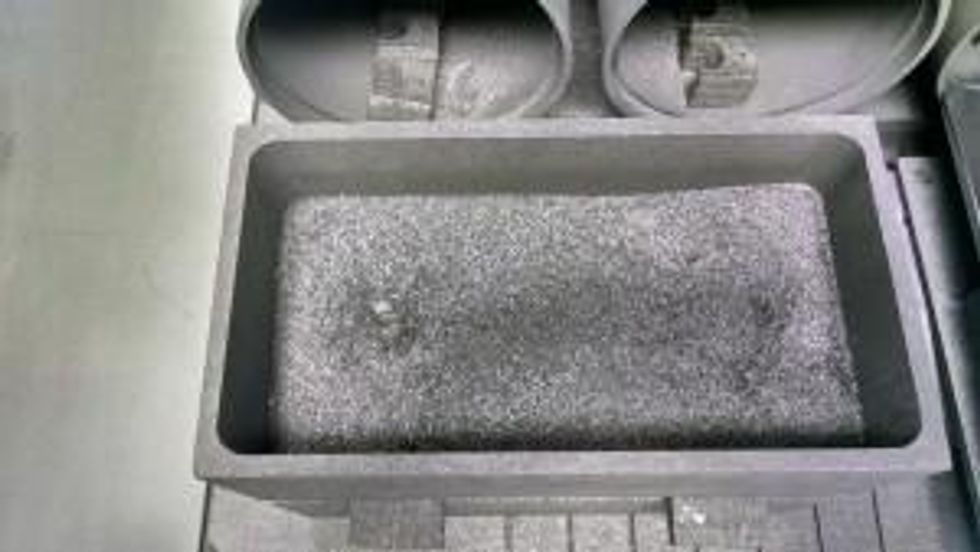Canada Carbon's R. Bruce Duncan Talks Transparency in the Canadian Graphite Space

R. Bruce Duncan, executive chairman and CEO of Canada Carbon, weighs in on the lack of transparency in the Canadian graphite industry and what he’s doing to combat it.
Quebec-focused Canada Carbon (TSXV:CCB) has received a lot of positive attention from graphite industry participants this year, and based on the news it’s been releasing, it’s not hard to see why.
The company has put out a steady stream of announcements since the start of 2015, with highlights including the release of impressive thermal upgrading results for hydrothermal lump/vein (HLV) graphite concentrate from its Miller project, and the news that Miller graphite is suitable for nuclear applications.
Most recently, Canada Carbon announced the receipt of indicative pricing for ultra-high purity, thermally upgraded (99.9998 percent C(t)) Miller HLV graphite, noting that a participant in the high-purity graphite market has provided a non-binding quotation of value of US$12,000 to US$14,000 per tonne. The participant is currently working with the company’s graphite.
At the time, R. Bruce Duncan, Canada Carbon’s executive chairman and CEO, commented positively on the quotation, noting that the company would be “working towards obtaining additional third party indicative pricing for other market segments” and including them in the preliminary economic assessment (PEA) for Miller, which is currently underway.
However, not everyone in the industry was quite so pleased with the quotation. The Investment Industry Regulatory Organization of Canada, better known as IIROC, stepped in after it was released, requesting that Canada Carbon provide further clarification. In the resulting release, Canada Carbon explains that the terms “indicative pricing” and “real-time pricing” are “neither industry standard nor defined terms in legislation.” The release also states that further graphite pricing information will be limited to disclosure in the coming PEA for Miller.
While some might see IIROC’s intervention as negative, for Duncan it was a catalyst to take a leading role in providing clarity in the Canadian graphite industry. He believes that the space lacks transparency — an issue Canada Carbon was attempting to combat with its initial release on indicative pricing — and that it’s up to industry participants like him to take the lead in remedying that situation.
Duncan spoke with the Investing News Network (INN) to provide further insight into why transparency is necessary, how he plans to bring the issue to the attention of regulators and the overall importance of graphite purity. Here’s what he had to say.
INN: NI 43-101 reporting standards are already in place to ensure that companies correctly report and display information on Canadian mineral projects. Why do those standards need to be modified for the graphite industry?
BD: NI 43-101 is a reporting standard for the mineral sector, and it was written to primarily guide public disclosure for public issuers in the base and precious metals sectors. NI 43-101 needs to be amended for the graphite sector in a similar fashion as was done with the diamond sector so that explorers can effectively disclose the prospectivity and potential of their graphite projects, to justify moving forward.
Specific guidelines were developed by the Canadian Institute of Mining (CIM) for the reporting of diamond exploration results, as well as diamond resources and reserves, which are incorporated by reference into NI 43-101. These sorts of guidelines were also developed for uranium, potash, coal and others, such that if the CIM guidelines change, the changes are automatically reflected in NI 43-101. The graphite sector needs the same sort of guidance as is available to the diamond sector because the value of a specific diamond deposit, or a graphite deposit, can vary tremendously from one deposit to the next.
The diamond sector guidelines provide an excellent illustration of why we need similar guidance for the graphite sector. One of the simplest statistics for evaluating a diamond deposit is the overall grade, which is reported as carats per tonne, or carats per 100 tonnes. But the value of the contained diamonds is determined by other factors as well, such as diamond color, clarity, crystal shape and crystal size. And the actual value of the contained diamonds is determined based on non-transparent market appraisals based on these other variables. The CIM diamond guidelines provide clearly defined terminology and reporting standards, leading not only to uniform reporting within the diamond sector, but also reporting that is consistent with the reporting from other sectors, providing readers with unambiguous information.
As with the diamond sector, the graphite sector has no benchmark pricing available to it, nor can a grade determination alone account for the wide number of variables affecting the value of any specific graphite. This makes it difficult to evaluate whether a project should go forward without pricing specific to that graphite deposit being established by an end-user at the bulk sample level, as is the case with diamonds today. Moreover, it makes comparisons between different graphite deposits nearly impossible, due to non-standardization of reporting. As stated in the preamble to the CIM diamond reporting guidelines, “[m]ateriality is the overriding principle that determines the information that should be disclosed.” The challenge facing the graphite sector is that there is little guidance on how to do so.
INN: How did you become interested in taking the lead in developing reporting standards for the Canadian graphite industry?
BD: Canada Carbon faced a regulatory review of our press release that referred to “indicative pricing” for Miller graphite based on the achieved purity of 99.9998 percent by thermal treatment. The pricing information was clearly material, but the lack of standardized graphite sector terminology and reporting standards were factors that prevented us from making unambiguous disclosure, despite regulatory review prior to its release to the public.
Canada Carbon is willing to take a leadership role in developing graphite sector reporting standards. We are currently putting together proposals for the regulators to consider. We will also be contacting our industry peers with a view to forming a graphite sector committee that would be tasked with assisting in the development of best practice guidelines.
INN: You’re clearly interested in helping the public understand as much as possible about Canada Carbon and its work. In closing, can you help investors understand the importance of graphite purity and how Canada Carbon achieved 99.9998 percent purity?
BD: Graphite purity is most commonly reported as a percentage by weight of graphite. For example, 95 percent graphite contains 5 percent by weight of other substances. For high-technology applications, the specific nature of the contaminants present in the graphite is just as important, if not more important, than the overall graphite purity number.
For example, graphite used in nuclear applications must not only have very high overall purity (99.995 percent carbon, i.e. 50 parts per million contaminant level (ASTM guideline)), but also the total contaminant load must include only very low concentrations of certain elements that could influence or participate in nuclear reactions. One of the adverse contaminant categories involves neutron capture, which is assessed by the Equivalent Boron Content (EBC), a statistic that combines the relative neutron capture contribution of 16 elements, reported as a single variable. The EBC must be below 2 parts per million.
Canada Carbon’s reported 99.9998 percent overall purity makes it among the purest graphites in the world today, even when compared to synthetic graphite. But as a natural graphite, the properties associated with crystallinity are superior to those seen in synthetic graphite. Our pilot plant flotation concentration program demonstrated that we can produce graphite concentrate at 97 to 99 percent purity. And with one simple upgrading process, using thermal treatment, we have achieved the 99.9998 percent purity level. We are in discussions with representatives from a number of graphite end-use market categories for which ultra-purity graphite is desirable, and anticipate receiving more letters describing pricing for a variety of different market segments.

What’s next?
Though it’s rarely easy to effect big changes in regulations, it’s clear that Duncan and Canada Carbon are ready to take the lead. Members of the Canadian graphite industry will no doubt be watching to see how the situation develops, and many will likely be keen to get involved. All in all, it’s hard to argue with the goal of setting up hard and fast standards to ensure harmony between regulators and companies.
Securities Disclosure: I, Charlotte McLeod, hold no direct investment interest in any company mentioned in this article.
Editorial Disclosure: Canada Carbon is a client of the Investing News Network. This article is not paid-for content.
Related reading:
Canada Carbon’s Miller Project Attracting Analyst Attention
Canada Carbon Starts Qualification Process for Offtakes
Canada Carbon Impresses with Thermal Upgrading Results





